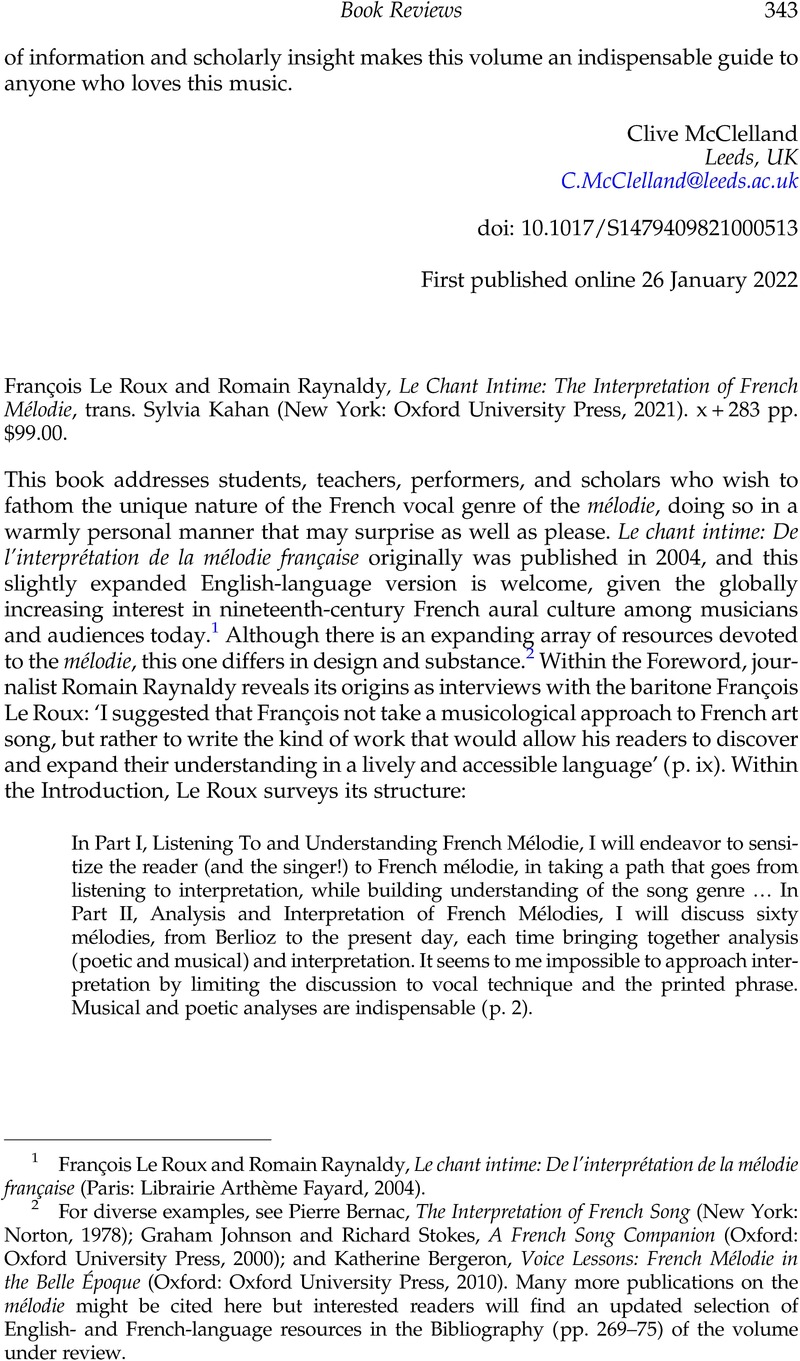No CrossRef data available.
Article contents
François Le Roux and Romain Raynaldy, Le Chant Intime: The Interpretation of French Mélodie, trans. Sylvia Kahan (New York: Oxford University Press, 2021). x + 283 pp. $99.00.
Review products
Published online by Cambridge University Press: 10 May 2022
Abstract

- Type
- Book Review
- Information
- Nineteenth-Century Music Review , Volume 19 , Special Issue 2: French Criticism , August 2022 , pp. 343 - 348
- Copyright
- Copyright © The Author(s), 2022. Published by Cambridge University Press
References
1 Roux, François Le and Raynaldy, Romain, Le chant intime: De l'interprétation de la mélodie française (Paris: Librairie Arthème Fayard, 2004)Google Scholar.
2 For diverse examples, see Bernac, Pierre, The Interpretation of French Song (New York: Norton, 1978)Google Scholar; Johnson, Graham and Stokes, Richard, A French Song Companion (Oxford: Oxford University Press, 2000)Google Scholar; and Bergeron, Katherine, Voice Lessons: French Mélodie in the Belle Époque (Oxford: Oxford University Press, 2010)Google Scholar. Many more publications on the mélodie might be cited here but interested readers will find an updated selection of English- and French-language resources in the Bibliography (pp. 269–75) of the volume under review.
3 While François Le Roux and Romain Raynaldy co-authored Le Chant Intime, the former's voice predominates within this resource through first-person phrasing, so this review frequently references his name.
4 The International Phonetic Alphabet originates with the International Phonetic Association. See The Handbook of The International Phonetic Association: A Guide to the Use of the International Phonetic Alphabet (Cambridge: Cambridge University Press, 1999). For more, see www.internationalphoneticassociation.org (accessed 11 January 2022).
5 See François Le Roux's recording with Graham Johnson, Songs by Louis Durey (Hyperion CDA67257; 2002).
6 Readers will be delighted that this book uses the ASA system for specific pitch indication, wherein ‘middle C’ is ‘C4’, rather than a nineteenth-century system like the Helmholtz, wherein ‘middle C’ is symbolized as ‘c'’. For instance, of ‘Le petit bois’ (1941) by Georges Auric, we read: ‘In a medium tessitura (from D♭3 to F4), it works well for either a male or female voice’ (p. 49).
7 A superb recording by François Le Roux and Jeff Cohen, Gabriel Fauré: Mélodies françaises (REM 311175; 1992), demonstrates how credible characters may be conjured with a responsive voice and a sensitive pianist. For evidence, compare and contrast the renditions of ‘Spleen’, ‘Mandoline’, and ‘Prison’, as well as those of ‘Nell’ and ‘Je me suis embarqué’, through which distinct personae of varying ages, circumstances, and moods musically materialize.
8 The chapters on Boulanger, Chaminade, Holmès, Jaëll, and Viardot are new in this edition, and they bring the total number of discussed songs to 60, from the 52 originally addressed in the 2004 version of the book.
9 For instance, see the brief discussion of Emmanuel Chabrier's ‘Tes yeux bleus’ (pp. 73–4) and the more expansive examination of Gabriel Fauré's ‘Cygne sur l'eau’ (pp. 141–8).
10 Most of the 110 musical illustrations – save 21, including those of Examples 7.1–7. 4 and 33.1–33.4 – feature metre signatures at the start, though many of these spans come from inside their compositions. Metre signatures of such interiorly located excerpts (like Examples 5.1–5.5 and 15.1–15.3) might have been consistently omitted or enclosed by parentheses or brackets.
11 Le Roux's recording of ‘Les grands vents venus d'outre-mer’ can be found on the compact disc Ravel: Mélodies (Le Chant du Monde, LCDM 2781131, 2001), by François Le Roux and Pascal Rogé. See also pp. 38–9 of Le chante intime for more on Pascal Rogé.
12 Le Roux's recording of ‘Sainte’ also can be found on the compact disc Ravel: Mélodies.
13 Of the paraphrase, readers learn that it was ‘written by René-Albert Gutmann (1885–1981) in his interesting – albeit biased – book, Introduction à la lecture des poètes français (published by Flammarion in 1946), which devotes an entire chapter to the poetry of Mallarmé’ (p. 225).
14 Perhaps these reiterated copyright notices serve within online access, or cope with copyright infringement, but an editorially added footnote seems warranted if such repetition represents a new publishing convention.
15 For instance, see pp. 50, 55, 72, 83, 88. Dotted lines mark stanza starts in the non-aligned texts and translations for Gabriel Fauré's ‘Tristesse d'Olympio’ (pp. 138–9) to aid comparisons, but perhaps misalignment might have been handled differently during print layout.
16 For example, in Chapter 2 we read that ‘the chanson is written in cyclic form, with verses and chorus’ (p. 17). Since ‘cyclic form’ (‘forme cyclique’) now commonly refers to multi-movement structuring frequently associated with César Franck, the term ‘alternating song form’ would be more appropriate. Later we encounter ‘Au cimetière’, by Berlioz, described as being set ‘in a simple strophic form (ABA′)’ (p. 31). Today, AAA customarily symbolizes strophic form, while ABA′ represents ‘simple ternary form’. For instances like these, editorially added correctives within footnotes would have been welcome.



